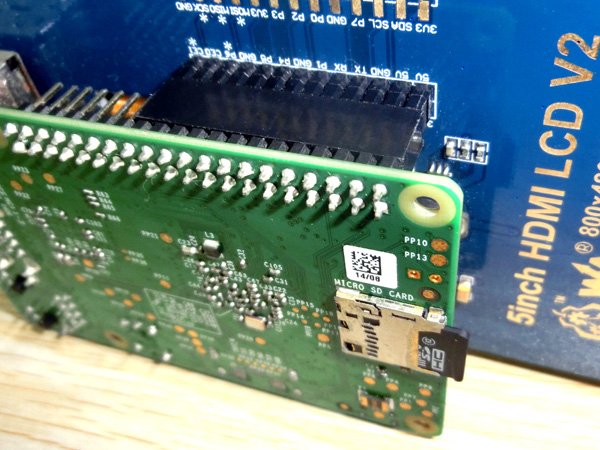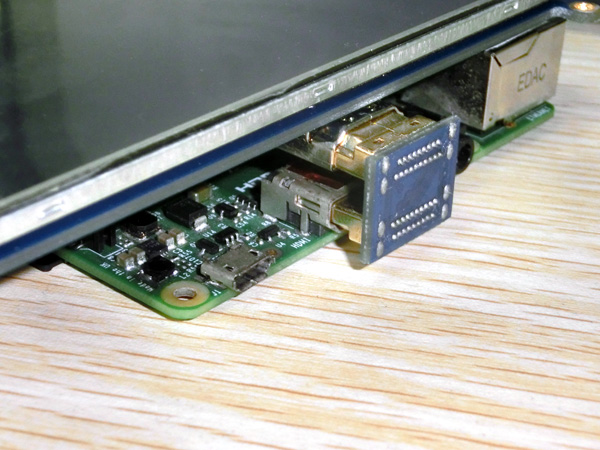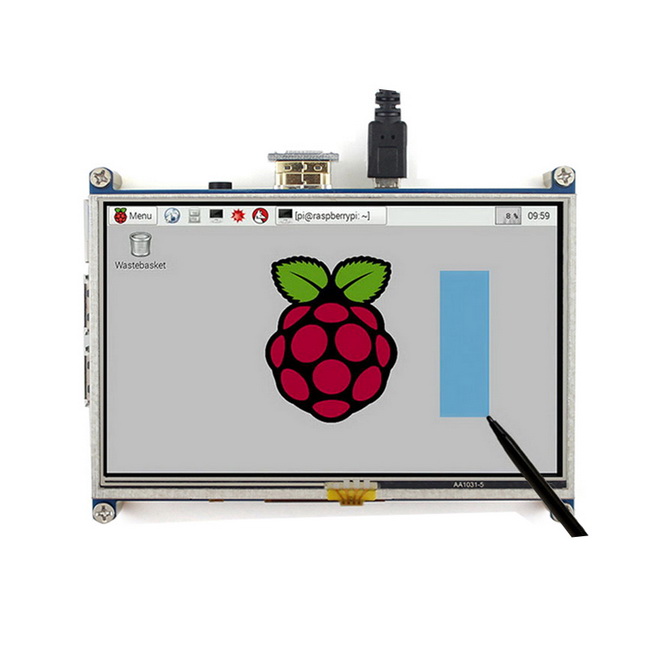- sales/support
Google Chat: zj734465502@gmail.com
- sales
+86-0755-88291180
- sales01
sales@spotpear.com
- sales02
dragon_manager@163.com
- support
tech-support@spotpear.com
- CEO-Complaints
zhoujie@spotpear.com
- sales/support
WhatsApp:13246739196
Raspberry Pi 5inch HDMI LCD User Guide
Introduction
5 inch Resistive Touch Screen LCD, HDMI interface, Designed for Raspberry Pi
Getting Started
Hardware Connection
- Plug the LCD to your Raspberry Pi:
- There are 40 pins on Raspberry Pi Model A+/B+/2 B/3 B but only 26 pins on the LCD, so you should pay attention to connecting the pins to your Pi accordingly.
- Connect the HDMI Connector to both the HDMI interfaces on the LCD and the Pi.
- You should connect the LCD to Raspberry Pi Model B or Raspberry Pi Zero with an HDMI cable rather than an HDMI Connector.
- Turn on the "backlight" switch on the back of the LCD.
Hardware connection
Plug the HDMI Connector
Note: This product can only work on a Raspberry Pi but not work on a PC. That is, if the HDMI of the LCD is connected to the HDMI on a PC, the LCD doesn't display anything.
You can enable the touch in two ways: Method 1. install driver to your Raspbian/Ubuntu Mate OS. Method 2. use the Ready-to-use image file of which LCD driver was pre-installed.
Method 1. Driver installation
Description: The driver can be downloaded from github
git clone https://github.com/waveshare/LCD-show.git
1) Download the Raspbian / Ubuntu Mate image from Raspberry Pi website and extract it on a PC.
2) Connect your micro SD card to the PC and write the image to the card using Win32DiskImager. How to write an image to a micro SD card for your Pi? See RPi Image Installation Guides for more details)
3) Copy the LCD driver to the micro SD card (or copy the driver to the system of Pi using a USB drive).
4) Append the following lines to the config.txt file which is located in the root of the card:
max_usb_current=1 hdmi_group=2 hdmi_mode=87 hdmi_cvt 800 480 60 6 0 0 0 hdmi_drive=1
【Note】If you use the LCD with Raspberry Pi 4B, you also need to remove/comment the line dtoverlay=vc4-fkms-V3D from config.txt file.
5) The LCD will display after booting up. Then open a terminal to install the touch driver which can be found in the /boot/ directory. Note: The Raspberry Pi must be connected to the network, or else the touch driver won't be successfully installed. The result is that a small area at the border cannot be touched. If you have installed the touch driver but without network connection, how to solve the problem? See: #Touch screen calibration part.
git clone https://github.com/waveshare/LCD-show.git cd LCD-show/ chmod +x LCD5-show ./LCD5-show
Touch function will work after restart. For ease of use, you can set the screen orientation, see: #Screen orientation settings.
Method 2. Using Ready-to-use image
The image file with pre-installed driver is located in the IMAGE directory of the CD, or you can download it from #Image. Extract the .7z file and you will get an .img file. Write the image to your micro SD card (How to write an image to a micro SD card for your Pi? See RPi Image Installation Guides for more details). Then insert the card to your Pi, power up and enjoy it.
Screen orientation settings
After touch driver installed, the screen orientation can be set by these commands:
- 0 degree rotation
cd LCD-show/ ./LCD5-show 0
- 90 degree rotation
cd LCD-show/ ./LCD5-show 90
- 180 degree rotation
cd LCD-show/ ./LCD5-show 180
- 270 degree rotation
cd LCD-show/ ./LCD5-show 270
- If Raspbian-lite is used, the commands should be
- 0 degree rotation
cd LCD-show/ ./LCD5-show lite 0
- 90 degree rotation
cd LCD-show/ ./LCD5-show lite 90
- 180 degree rotation
cd LCD-show/ ./LCD5-show lite 80
- 270 degree rotation
cd LCD-show/ ./LCD5-show lite 270
Touch screen calibration
If a latest Raspbian OS is in used, you should connect your Pi to the internet and install xserver-xorg-input-evdev.
sudo apt-get install xserver-xorg-input-evdev
- Just be sure that evdev.conf has a higher number than 40-libinput.conf. For example, rename 10-evdev.conf to 45-evdev.conf. this forces evdev to load after libinput.
sudo cp -rf /usr/share/X11/xorg.conf.d/10-evdev.conf /usr/share/X11/xorg.conf.d/45-evdev.conf sudo reboot
- This LCD can be calibrated using a program called xinput_calibrator which can be downloaded from Xinput-calibrator_0.7.5-1_armhf.
- Extract and copy the software Xinput-calibrator_0.7.5-1_armhf.deb to the Raspbian of your Pi.
- Install it with the commands:
sudo dpkg -i -B xinput-calibrator_0.7.5-1_armhf.deb
- Click the "Menu" button on the task bar, choose "Preference" -> "Calibrate Touchscreen".
- Finish the touch calibration following the prompts. Maybe rebooting is required to make calibration active.
- You can create a 99-calibration.conf file to save the touch parameters (not necessary if file exists).
/ect/X11/xorg.conf.d/99-calibration.conf
- Save the touch parameters (may differ depending on LCD) to 99-calibration.conf, as shown in the picture:

Interface
| PIN NO. | SYMBOL | DESCRIPTION |
|---|---|---|
| 1, 17 | 3.3V | Power positive (3.3V power input) |
| 2, 4 | 5V | Power positive (5V power input) |
| 3, 5, 7, 8, 10, 11, 12, 13, 15, 16, 18, 24 | NC | NC |
| 6, 9, 14, 20, 25 | GND | Ground |
| 19 | TP_SI | SPI data input of Touch Panel |
| 21 | TP_SO | SPI data output of Touch Panel |
| 22 | TP_IRQ | Touch Panel interrupt, low level while the Touch Panel detects touching |
| 23 | TP_SCK | SPI clock of Touch Panel |
| 26 | TP_CS | Touch Panel chip selection, low active |






